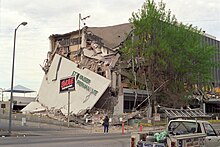The
Northridge earthquake was a massive earthquake that occurred on January 17, 1994, at 04:31
Pacific Standard Time in
Reseda, a neighborhood in the city of
Los Angeles, California, lasting for about 10–20 seconds. The
earthquake had a "strong"
moment magnitude of 6.7, but the
ground acceleration was one of the highest ever instrumentally recorded in an urban area in North America, measuring 1.7
g (16.7 m/s
2) with strong ground motion felt as far away as
Las Vegas, Nevada,
over 270 miles (435 km) from the epicenter. The death toll came to a
total of 57 people, and there were over 8,700 injured. In addition, the
earthquake caused an estimated $20 billion in damage, making it one of
the costliest natural disasters in U.S. history.
The earthquake struck in the
San Fernando Valley about 20 miles (31 km) northwest of downtown Los Angeles near the community of
Northridge. The actual epicenter of the quake was in
Reseda, near the intersection of
Reseda Boulevard
and Strathern Street. However, it took several days to pinpoint the
epicenter with accuracy, and in the meantime the media had already
dubbed it "The Northridge Earthquake." The name stuck, in part due to
the extensive damage and loss of life in Northridge. The
National Geophysical Data Center places the hypocenter's geographical coordinates at
34°12′47″N 118°32′13″W and a depth of 17 km (10.56 mi). Despite the area's proximity to the
San Andreas Fault, the Northridge quake did not occur along this fault, but rather on the previously undiscovered Northridge
blind thrust fault (also known as the Pico thrust fault).
Damage and fatalities
Damage occurred up to 85 miles (125 km) away, with the most damage in the west San Fernando Valley, and the cities of
Santa Monica,
Simi Valley and
Santa Clarita.
The number of fatalities is not certain, with sources estimating it at
60 or "over 60", to 72, where most estimates fall around 60. The
"official" death toll was placed at 57. 33 people died immediately or
within a few days from injuries sustained in the earthquake, and many
died from indirect causes, such as stress-induced
cardiac events. Some counts factor in related events such as a man's
suicide possibly inspired by the loss of his business in the disaster.
More than 8,700 were injured including 1,600 that required hospitalization.
The Northridge Meadows apartment complex was one of the well-known
affected areas in which sixteen people were killed as a result of the
building's collapse. The
Northridge Fashion Center and
California State University, Northridge
also sustained very heavy damage—most notably, the collapse of parking
structures. The earthquake also gained worldwide attention because of
damage to the vast freeway network, which serves millions of commuters
every day. The most notable of this damage was to the
Santa Monica Freeway, Interstate 10,
known as the busiest freeway in the United States, congesting nearby
surface roads for three months while the freeway was repaired. Further
north,
Interstate 5 (the
Golden State Freeway) and
State Route 14 (the
Antelope Valley Freeway) collapsed and had to be rebuilt. The
Newhall Pass interchange of
Interstate 5 and
State Route 14 collapsed as it had 23 years earlier during the 1971
Sylmar earthquake
even though it had been rebuilt with improved structural components.One
life was lost in the Newhall Pass interchange collapse:
LAPD
motorcycle officer Clarence W. Dean fell 40 feet from the damaged
connector from southbound 14 to southbound I-5 along with his
motorcycle. Because of the early morning darkness, he was unaware that
the elevated roadway beneath him had dropped, and was unable to stop in
time to avoid the fall and died instantly. When the interchange was
rebuilt again one year later, it was renamed the Clarence Wayne Dean
Memorial Interchange in his honor.
Additional damage occurred about 50 miles (80 km) southeast in
Anaheim as the scoreboard at
Anaheim Stadium
collapsed onto several hundred seats. The stadium was empty at the
time. Although several commercial buildings also collapsed, loss of life
was minimized because of the early morning hour of the quake, and
because it occurred on a Federal holiday (
Martin Luther King, Jr. Day). Also, because of known seismic activity in California, area
building codes dictate that buildings incorporate
structural design
intended to withstand earthquakes. However, the damage caused by the
earthquake revealed that some structural specifications did not perform
as well as expected. Because of this building codes were revised. Some
structures were not
red-tagged until months after the earthquake because damage was not immediately apparent.
The quake produced unusually strong ground accelerations in the range of 1.0
g.
Damage was also caused by fire and landslides. The Northridge
earthquake was notable for striking almost the same area as the M
W 6.6
San Fernando (Sylmar) Earthquake. Some estimates of total damage range as high as $25 billion.
Most
casualties and damage occurred in multi-story wood frame buildings
(e.g. the three-story Northridge Meadows apartment building). In
particular, buildings with an unsteady first floor (such as those with
parking areas on the bottom) performed poorly. Numerous fires were also
caused by broken gas pipes due to houses shifting off foundations or
unsecured water heaters falling over.
In the San Fernando Valley, several underground gas and water mains
were severed, resulting in some streets experiencing simultaneous fires
and floods. As is common in earthquakes,
unreinforced masonry buildings
and houses on steep slopes suffered damage. However, school buildings
(K-12), which are required to be reinforced against earthquakes, in
general survived fairly well.


![]()
![]()
![]()
